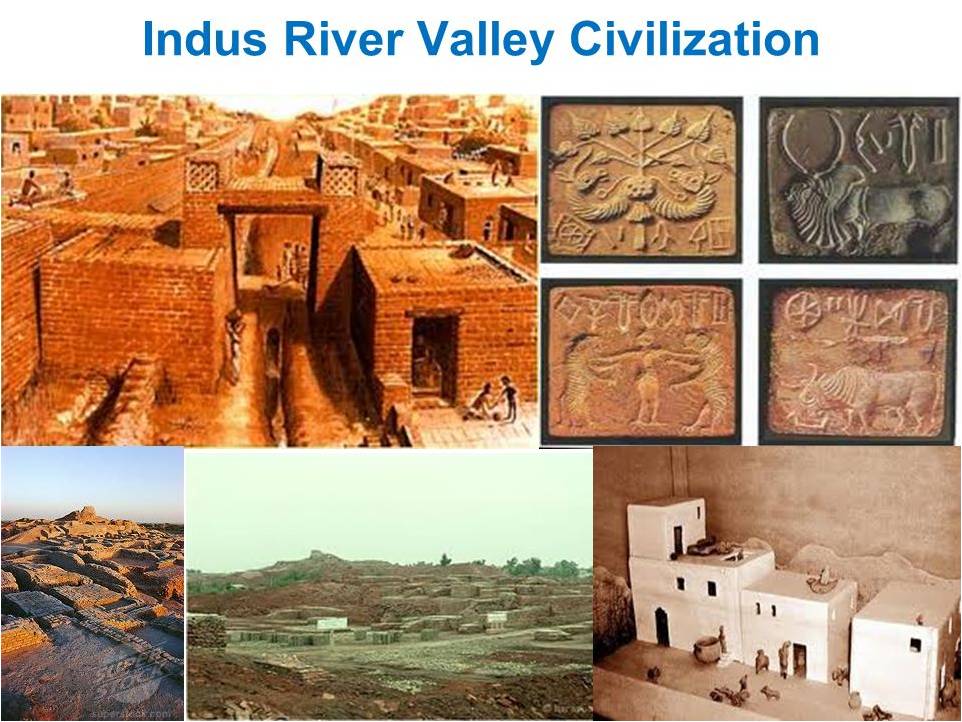
Why Indus Valley Civilization is Important for India ?
To counter Narrative
The discovery of IVC was significant as it helped counter British colonial narratives of their superior civilizational values and traditions which propagated barbarism of the east and superiority of the West that gave rise to the idea of ‘white man’s burden’.
Britishers took advantage of this idea to justify their 200 years of rule
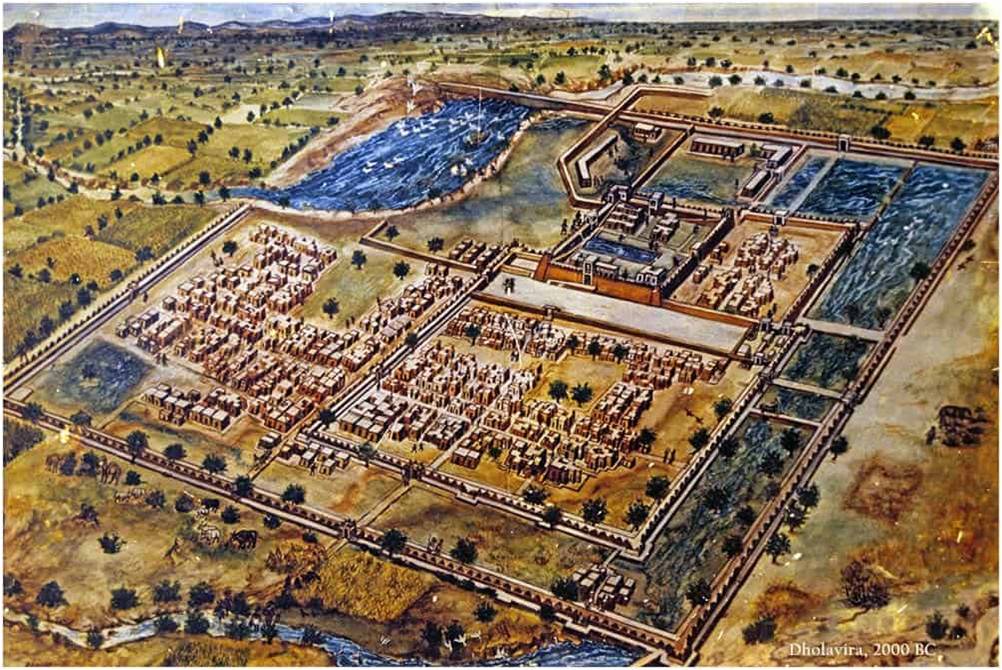
The history of India begins with the birth of the Indus Valley Civilization (IVC),also known as Harappan Civilization.
It flourished around 2,500 BC, in the western part of South Asia,in contemporary Pakistan and Western India.
The Indus Valley was home to the largest of the four ancient urban civilizationsof Egypt, Mesopotamia, India and China.
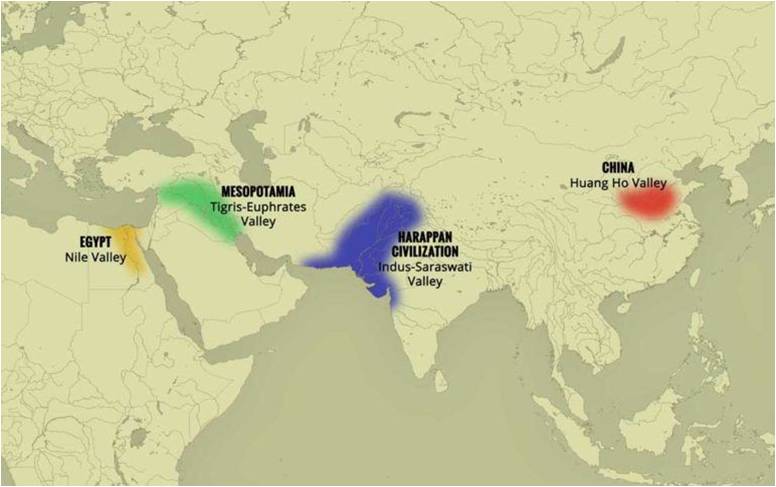
Expansion of Indus valley Civilization
The known extent of IVC is up to Suktagendor in Baluchistan in the west; Alamgirpur (UP) in the east; Daimabad (Maharashtra) in the South; and Manda (Jammu & Kashmir) in the north.
The extent of the excavations till now is- Manda northernmost, Daimabad(Southernmost), Alamgirpur(Easternmost), and Sutkagan Dor(Westernmost).
Most of the cities were located in present-day India and Pakistan.Except for Shortughal which is located in Afghanistan and was perhaps the trading colony of Harrapans.
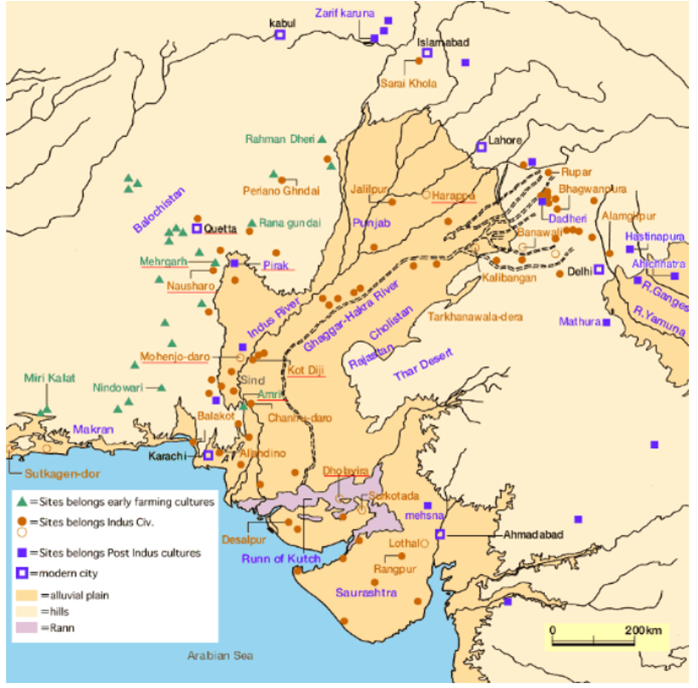
EXCAVATIONS IN BRITISH INDIA AND INDEPENDENT INDIA
Although Charles Masson described the ruins of Harappa in his Narrative of Various Journeys in Baluchistan, Afghanistan, and Punjab(1842), their significance was not realized until much later.
The British used Harappan bricks in the construction of the East Indian Railway line connecting Karachi and Lahore in 1857.
Sir Alexander Cunningham excavated the Harappa site for the first time in 1872-73, two decades after brick robbers took the visible remains of the city. He discovered an unknown Indus seal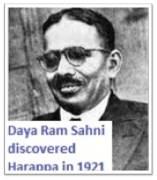
In 1912 J. Fleet discovered Harappan seals leading to an excavation campaign under Sir John Marshall in 1921 resulting in the discovery of the Harrapan civilization by Dayaram Sahani that took everyone y surprise due to its uniqueness which even inspires us today and even burst the myth of Europeans who thought they had a monopoly on civilizations and cultured values.
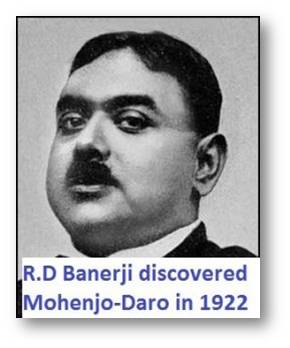 In 1922, RD Banerjee excavated Mohenjo Daro.
In 1922, RD Banerjee excavated Mohenjo Daro.
British archaeologist Aurel Stein, Indian archaeologist Nani Gopal Majumdar, R. Rao, JP Joshi, Vasant Sinha, Amianand Ghose, R.S.Bisht, and German archaeologist Michael Jansen were all influential in the field.
Phases of Indus Valley Civilization
Three phases of IVC are:
- the Early Harappan Phase from 3300 to 2600 BCE,
- the Mature Harappan Phase from 2600 to 1900 BCE, and
- the Late Harappan Phase from 1900 to 1300 BCE
Pre Harrapa-The first period of IVC is called ‘Pre-Harappa’ which goes back to 3300 BCE.
Early Harrapa- During this time, the nomadic people started living settled lives and picked up agriculture. The period between 3300 BCE-2600 BCE was called ‘Early Harappa’. Massive villages and urban centers emerged during this period. The Indus script dates back to around 3000 BC, putting the origins of writing in South Asia around the same time as Ancient Egypt and Mesopotamia
Mature Harappan’ is referred to the period between 2600 BCE to 1900 BCE. During this period, large urban centers flourished in the Indus valley civilization. Mercantilism was at its peak during this phase.
‘Late Harappan’ phase is between 1900 BCE and 1300 BCE. During this period, civilization declined
Salient Features – Town Planning and Structures
The Harappan culture was distinguished by its system of town planning.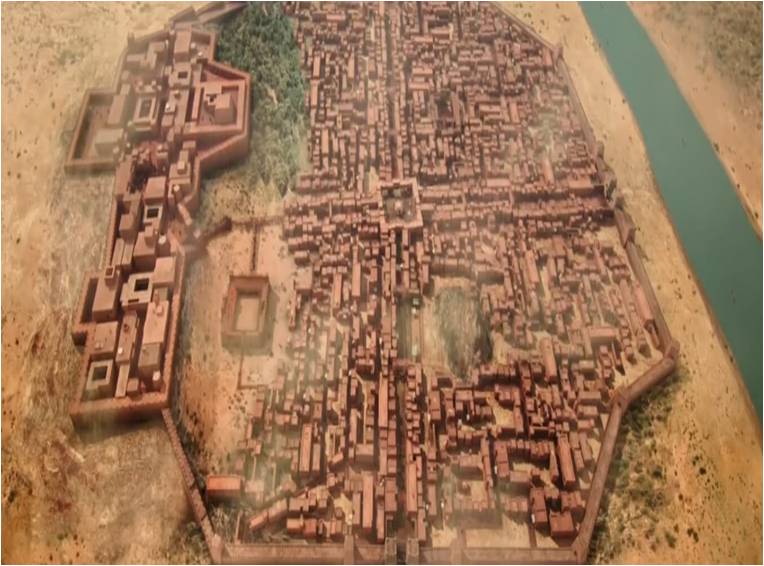
Harappa and Mohenjodaro each had its own citadel or acropolis, which was possibly occupied by members of the ruling class.
Below the citadel in each city lay a lower town containing brick houses, which were inhabited by the common people.
The remarkable thing about the arrangement of the houses in the cities is that they followed the grid system.
Granariesconstituted an important part of the Harappan cities.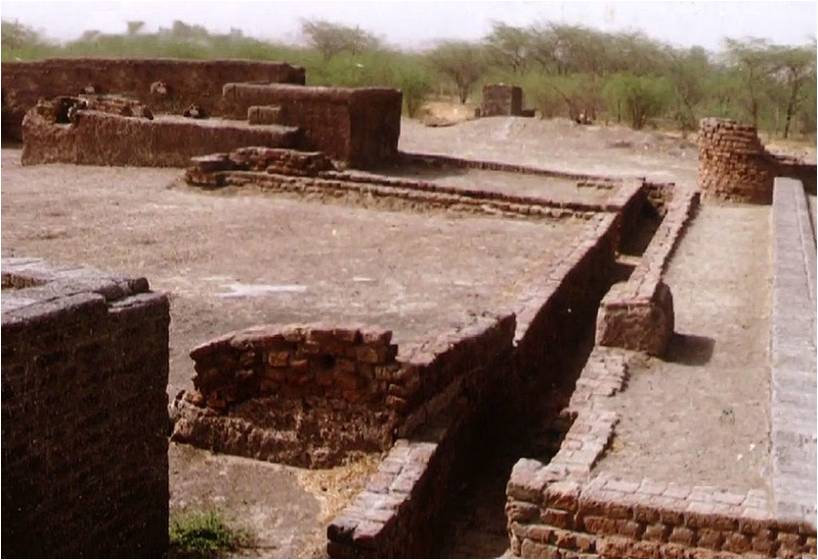
The use of burnt bricksin the Harappan cities is remarkable, because in the contemporary buildings of Egypt mainly dried bricks were used.
The drainage systemof Mohenjodaro was very impressive.
In almost all cities every big or small house had its own courtyard and bathroom.
In Kalibangan many houses had their wells.
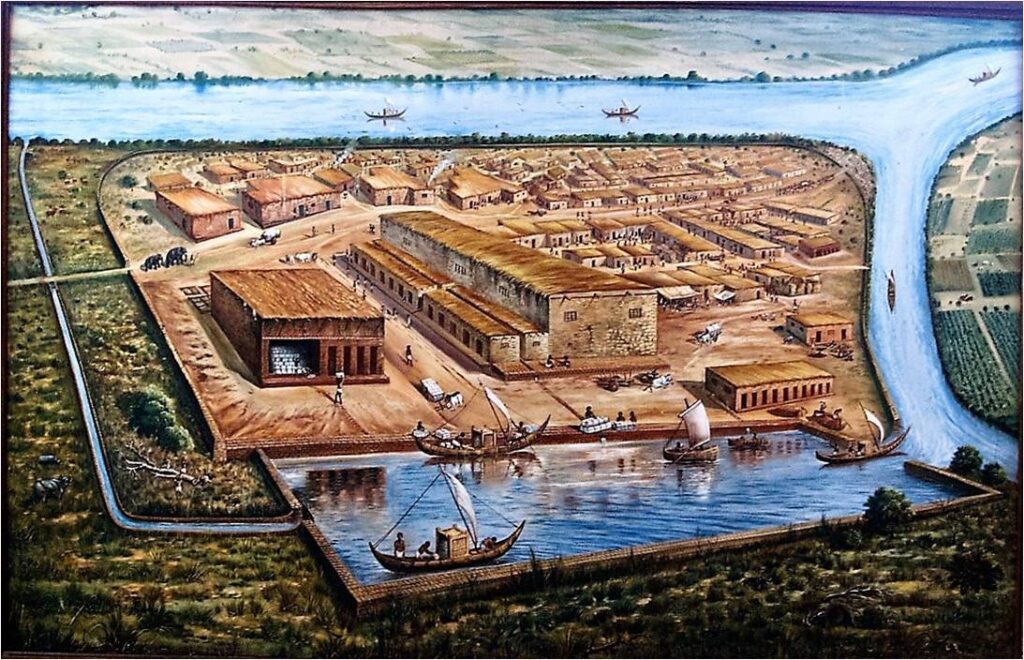
At sites such as Dholavira and Lothal (Gujarat), the entire settlement was fortified, and sections within thetown were also separated by walls.
Salient Features – Agriculture
The Harappan villages, mostly situated near the flood plains,produced sufficient food grains.
Wheat, barley, rai, peas, sesame, lentil, chickpea and mustard were produced.
Millets are also found from sites in Gujarat. While rice uses were relatively rare.
The Indus people were the earliest people to produce cotton.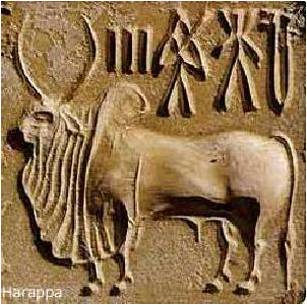
Although the Harappans practised agriculture, animals were also reared on a large scale.
Representations on seals and terracotta sculpture indicate that the bull was known, and archaeologists extrapolate shows oxen were also used for ploughing
Evidence of the horse comes from a superficial level of Mohenjodaroand from a doubtful terracotta figurine from Lothal. In any case the Harappan culture was not horse centered.
Salient Features – Economy
The importance of trade in the life of the Indus people is witnessed by the presence of numerous seals, uniform script and regulated weights and measuresin a wide area.
The Harappans carried on considerable trade in stone, metal, shell,etc.
Metal money was not used and trade was carried by barter system.
They practiced navigation on the coast of the Arabian Sea.
They had set up a trading colony in northern Afghanistanwhich evidently facilitated trade with Central Asia.
They also carried commerce with those in the land of the Tigris and the Euphrates.
The Harappans carried on long distance trade in lapis lazuli; which may have contributed to the social prestige of the ruling class.
Salient Features – ART AND CRAFT
The Harappan people also had well-developed knowledge of a variety of artifacts and sculptures.
Art and crafts were a common practice but the cities of Chunandaro, Balakot, and Nageshwar were the famous industrial towns and many crafts can be found in Indian and British museums.
The production of bronze tools and other crafts, and widespread trade and commerce all contributed to the rise of towns in the Indus Valley. Harappa’s people used a variety of stone tools and implements, but they were also well-versed in the production and use of bronze. Harappan cities were also home to several important crafts.
Salient Features – Seals
They are the greatest artistic creations of the Indus people.
Most commonly made of steatite (soft stone).
The technique of cutting and polishing these seals with white luster was a unique invention of the Harappans.
The majority of the seals have an animal engraved on them with a short inscription.
Unicorn is the animal most frequently represented on the seals.
Main type – (a) the square type with a carved animal and inscription, (b) the rectangular type with inscription only.
Salient Features – STONE SCULPTURES/STONE STATUES
The Bearded man sculpture made of steatite or soap rock is also one of the famous and extensively discussed sculptures of Mohenjadaro.
This sculpture has been identified as a possible ‘priest’ in ancient times.
The bearded man is draped in a shawl that runs under his right arm and covers his left shoulder.
Trefoil patterns are used to decorate this shawl.
As in meditative concentration, the eyes are slightly elongated and half-closed.
Salient Features – BRONZE CASTING
Dancing girl, a four-inch-high copper figure of a dancing girl in Tribhanga posture is one of the most well-known Indus Valley artifacts.
This exquisite casting, discovered in Mohenjodaro, depicts a girl with long hair tied in a bun.
Her left arm is covered in bangles, her right arm is adorned with a bracelet and an amulet or bangle, and her neck is adorned with a cowry shell necklace.
Salient Features – Others
The spinning of cotton and wool was very common, as evidenced by the discovery of a large number of spindles and spindle whorls in the houses of the Indus Valley.. Men and women wore dhotis and shawls, which were two separate pieces of clothing.
Harappans were also aware of boat-making craft and the boats were used in sea trades with other civilizations.
The Harappan also used standard weight measures which were in multiples of 16 units. It is similar to the modern weight measures system
Salient Features – Religion
The chief male deity was the Pashupati Mahadeva (Mohenjadaro), represented in seals as sitting in a yogic posture on a low throne, and having three faces and two horns. He is surrounded by four animals (elephant, tiger, rhino and buffalo), each lacing a different direction, and two deer appear at his feel.
The chief female deity was the Mother Goddess(Harrappa), who has been depicted in various forms
There is sufficient evidence for the prevalence of phallic worship. Numerous stone symbols of female sex organs (yoni worship), besides those of the phallus, have been discovered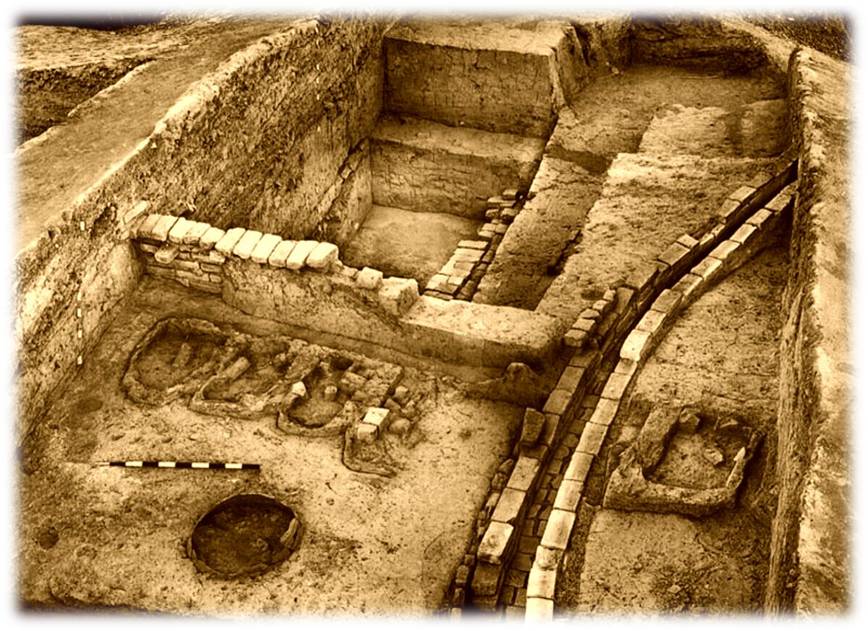
The worship of fire is proved by the discovery of fire altars at Lothal. Kalibangan and Harappa.
Indus people also worshipped Gods in the form of trees (pipal, etc.) and animals (unicorn etc)
Further they believed in ghosts and evil forces and used amulets as protection against them.
Salient Features – Burial Practices
Three forms of burials are found at Mohenjodaro, viz. complete burials. fractional burials (burial of some bones after the exposure of the body to wild beasts birds) and post-cremation burials.
Post – cremation urn burials predominant at Mohenjodaro area while pot/urn burials are found largely at kalibangan.
In Lothal – Joint burial of male and female is discovered
In Harappa – coffin burial system founded
In Ropar a man was found buried with a dog
Salient Features – Burial Practices
Harappan People Buried as a Couple Found at Site in Rakhigarhi Haryana (2019).
Vasant Shinde, toldBBCthat the man and the woman were facing each other in an “intimate way” and that they “seemed to have died at the same time”.
The man was aged about 35 and the woman, about 25. The group hasn’t been able to discern their causes of death.
For instance, a Harappan joint burial discovered at Lothal [in Gujarat] was regarded as a probable instance of a widow’s self-sacrifice demonstrative of grief over her husband’s death. Others contrarily claimed that it was difficult to estimate the sexes of the individuals, and that therefore, they might not have been a couple.
Salient Features – Trade and Commerce
Inter regional trade was carried on with Rajasthan, Saurashtra, Maharashtra. South India, parts of Western Uttar Pradesh and Bihar.
Foreign trade was conducted mainly with Mesopotamia and Bahrain. Trade was carried on by overland as well as overseas transport.
Bullock carts and pack-oxen were employed for land transport.
There is evidence of sea and river transport by ships and boats in several seals and terracotta models, apart from the dockyard at Lothal.
The Sumerian texts refer lo trade relations with Meluha’ which was the ancient name given to Indus region and they also speak of two intermediate stations called Dilmun (identified with Bahrain) and Makan (Makran coast)
Decline of Indus Valley Civilization
After 2000 BC, the Indus culture slowly declined and gradually faded out. Some ascribe this to the decreasing fertility of the soil on account of the increasing salinity, caused by the expansion of the neighboring desert.
Others attribute it to some kind of depression in the land, which caused Hoods.
Still others point out that the Aryans destroyed it.
According to some scholars, decline of trade, particularly oceanic trade with the Sumerians, must have contributed partly in the decline.
Even though there are various theories for the downfall of this civilization, the most accepted version is that of ecological destruction.





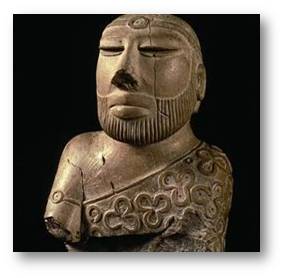
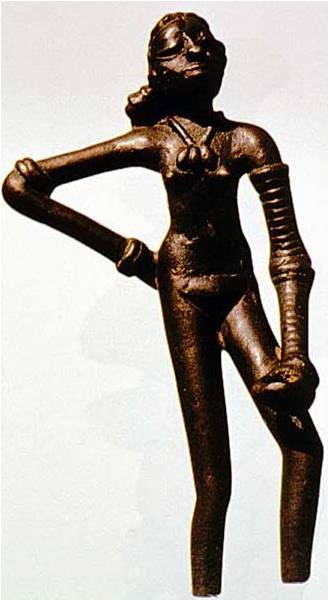

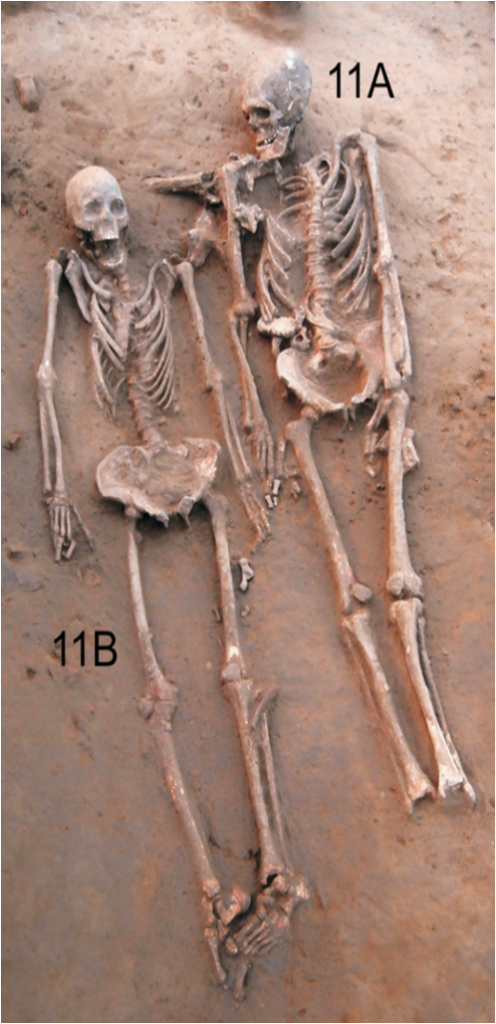



No comment